Deep in Colorado's national forests, shadowy teams of people are clearcutting underbrush, trenching hillsides for cultivation, diverting and damming streams to create reservoirs and using chemicals that are killing fish and wildlife. They leave behind animal carcasses, garbage and human waste, polluting mountain streams.
And the destruction is spreading.
In a state where growing and selling cannabis have been legal for years, illegal marijuana grow operations in national forests have been on the rise for at least the last three years, officials say.
In 2017, 71,000 pot plants were eradicated in the U.S. Forest Service's five-state Rocky Mountain Region. That's up from 45,000 plants in 2016, 23,000 plants in 2015 and just 3,000 plants in 2014 - the vast majority each year in Colorado. In a report to Congress in 2016, the Forest Service estimated each plant to be worth $2,500, making the street value of the plants eradicated last year in the Rocky Mountain region more than $177 million.
Last October, Forest Service officials, the Fremont County sheriff's department and other agencies seized 4,200 marijuana plants growing on the San Isabel National Forest and arrested four suspects living in the U.S. illegally.
The month before, a raid of a five-acre site near Carbondale on the White River National Forest netted 2,700 pot plants. And in July 2017, 7,400 plants were seized from two Pueblo County sites on the San Isabel National Forest.
All this has some lawmakers sounding an alarm that foreign drug cartels are behind the problem, although officials on the ground say evidence of widespread cartel involvement is lacking.
And despite popular notions of pot plantations guarded by heavily-armed criminals and boobytraps, the region's top U.S. Forest Service law enforcement official says illegal grows on public lands pose more of an environmental threat than a public-safety one.
"The time I've been here, fortunately, we haven't had any armed confrontations, but we're always prepared for that just like any law enforcement officer going to serve a search warrant on a house in a city environment," Kent Delbon, special agent in charge for the Forest Service's Rocky Mountain Region, told Colorado Politics. "Our biggest concern really is the environmental component."
The Lakewood-based region includes Colorado, Wyoming, South Dakota, Nebraska and Kansas.
Delbon has been its top special agent for two years, and before that he served for six years as an assistant special agent for the Forest Service in California after stints with both the Los Angeles Police Department and the U.S. Secret Service.
In his eight total years with the Forest Service, Delbon said he's helped eradicate more than 100 illegal grow sites, and has never once seen a boobytrap.
"It's not like you have snipers out waiting for people or law enforcement to come into the grow site," Delbon said. "Fortunately, the experience I've had, even in California, the growers themselves are typically the low worker bees. (When a raid happens,) they want to get out of there and avoid arrest."
Most grows, for obvious reasons, are way off the beaten track and far from recreation areas, campgrounds and marked trails, Delbon added. "So, for the vast majority of the public recreating on our posted trails, the risk is very low."
Still, concern runs high about illegal grows on public land and their impact.
More illegal plants are being discovered and destroyed on Forest Service land in Colorado since voters approved growing, selling and consuming recreational marijuana with the passage of Amendment 64 in 2012, officials say. All of those activities are still illegal on national forests, Bureau of Land Management acreage and other federally owned land, which covers about a third of the state.
Some Republican politicians from Colorado have taken notice of the increase, linking the spike in illegal grows to Mexican drug cartels. That narrative aligns with the current push by President Donald Trump and others for increased border security.
"Our area's federal lands have been exploited by drug cartels who use the land for illegal marijuana grows," U.S. Rep. Doug Lamborn, R-Colorado Springs, said in a recent press release. "These sites are often protected by heavily armed cartel members who pose a serious safety risk to those who utilize our public lands for recreational activities as well as for Forest Service and BLM staff."
A spokeswoman for U.S. Rep. Scott Tipton, R-Cortez, whose 3rd Congressional District includes large areas of public lands on the Western Slope, told Colorado Politics that "while we don't know who is responsible for all of the grows, ... the congressman has met with representatives from the Drug Enforcement Agency and local police officials to discuss the prevalence of cartel activity in the 3rd Congressional District and believes it is imperative that we secure the U.S.-Mexico border to stop the illegal flow of drugs and money."
But while federal and local law enforcement officials acknowledge safety concerns stemming from the growing pot trend, some say it's premature to make the leap to assume widespread cartel activity is behind it.
Eagle County Sheriff James Van Beek - whose county includes huge swaths of White River National Forest, the most visited national forest in the nation - said no illegal grows in Eagle County have been linked to cartels.
"There have been trends throughout the U.S. where it is believed ... the cartels are behind many of the major grows. ... Here in Eagle County, we suspected a couple may have been, but cannot confirm that to be the case," Van Beek said.
Back in 2015, then-U.S. Attorney for Colorado John Walsh, an Obama administration appointee, said: "We have concern (that) ... drug trafficking organizations from Mexico are involved in growing marijuana here in Colorado. Outside drug trafficking organizations may come to Colorado with the notion it may go unnoticed because of the amount of marijuana activity."
Since Trump took office, Bob Troyer, an Obama-administration holdover, has been serving as U.S. attorney in Colorado.
Asked now about the illegal-grow situation, a spokesman for the U.S. attorney's office would not comment on any cartel connections.
"The prosecution of marijuana grown on federal public land has been, and remains, an enforcement priority for the United States Attorney's Office," the spokesman said in an email statement. "We work closely with our partners in the state and federal government to prosecute these cases."
In a review of court files from several prosecutions stemming from raids in 2017, Colorado Politics found examples of Mexican nationals working in coordination with outside groups to grow pot on public lands. In plea agreements, growers described moving to the state to be "weed farmers" for $200 a day, while being supplied by and connected to trafficking organizations.
And while several nationals of Mexico and other Latin American countries have been arrested and successfully prosecuted for growing marijuana on Colorado's public lands, it's unclear how many of those grow operations have connections to organized Mexican drug cartels.
"Generally, we find that it's a mix, whether it's local residents or maybe some other group that comes into the area, but to specifically tie it back to cartels, that's probably not appropriate to make those connections at this point," Delbon, the Forest Service agent, said.
Neither Delbon nor Van Beek would speculate on the nature of the black market for illegal grows on public lands and whether the pot is being sold out of state. The Denver office of the Drug Enforcement Administration did not return a call seeking comment.
Of the five states that make up the 40-million-acre Rocky Mountain Region of the Forest Service, only Colorado has legalized marijuana for either medical or recreational use. But nationally, eight states with huge tracts of federal land - from Alaska to Nevada - have voted to legalize pot for recreational use. And the majority of states have approved medical use.
Delbon said he can't weigh in yet on whether there's a correlation between Colorado legalizing recreational marijuana in 2012 and the increased number of plants being illegally grown on federal lands in the state.
"Maybe the better answer for me is it's too soon to tell," Delbon said.
In any event, while the number of plants is going up on public lands, Delbon said law enforcement resources have stayed about the same in recent years, with one Forest Service officer assigned to each ranger district and a special agent assigned to each of Colorado's eight national forests.
Delbon declined to provide the exact number of Forest Service agents, but one of those eight national forests - the Pike-San Isabel National Forest and Cimarron and Comanche National Grasslands, administered jointly - has six ranger districts plus the two grasslands encompassing 3 million acres. That's a lot of territory to cover for about seven Forest Service cops.
The Forest Service partners with local, state and other federal agencies to take down grow operations, which mostly consists of destroying pot plants and mitigating the damage.
While hunters way off the main trails looking for game sometimes discover grows, Delbon said the good old-fashioned police work of local sheriffs' departments leads to the highest number of eradicated plants.
"When grows are found on public lands, depending on their size, we may monitor them for a few days to see if we can discover who is growing them, but more often than not we just destroy the operation," said Van Beek, the Eagle County sheriff.
Forest Service land often provides more lush, hidden-away locations for illegal growers, and while the chances of stumbling onto such a site are low, Forest Service officials ask the public to be vigilant and to take note of the location, get out quickly and call the local sheriff if a grow site is discovered.
While Colorado's generally higher, well-watered national forests have seen steady expansion of illegal marijuana grows, that's less the case on the state's lower, more arid BLM lands.
"We are taking the same actions we have taken in previous years, and we have not seen a dramatic increase in illegal grows or the eradication of illegal grows," said BLM spokesman Steven Hall.
The U.S. Department of the Interior - parent of the BLM and National Park Service, among other lands agencies - is using drones in the fight.
"To help local law enforcement in targeting trafficking operations, (Interior) is implementing the use of Unmanned Aircraft Systems as a means to detect hard-to-reach grow sites for law enforcement as well as a tool to proactively identify high-probability grow areas that could become compromised in the future," Interior spokeswoman Heather Swift said in an email to Colorado Politics.
As for bolstering efforts to deal with illegal grows on public lands, more enforcement help from the state is on the way, said Shelby Wieman, spokeswoman for Gov. John Hickenlooper. She pointed to the governor's signing last year of House Bill 1221, which created a $6 million grant program to support local law enforcement in cracking down on marijuana black-market activities.
"Public health and safety are our top priorities. The state is committed to working with federal law enforcement to eliminate the black market," Wieman said.
The spokeswoman for Tipton said the congressman has asked for additional funding for the High Intensity Drug Trafficking Area program for the 2019 fiscal year. It's a program that aims to provide assistance to federal, state and local agencies operating in areas deemed to be "critical drug-trafficking regions," including several Colorado counties that contain public lands.
But Delbon said that while local sheriffs have been of great help combating illegal growing on public lands, other law enforcement agencies in Colorado tend to be focused elsewhere.
"It's been my perception at least that the state has been focusing more on the indoor grows, the house grows, the (legal growing) compliance, that side of it, where if we have a grow out on the forest, we're working with our sheriffs, whether it's Eagle County, Pueblo County, Custer County," Delbon said. "Those folks are the ones that we've been working with directly, and they've been providing support."


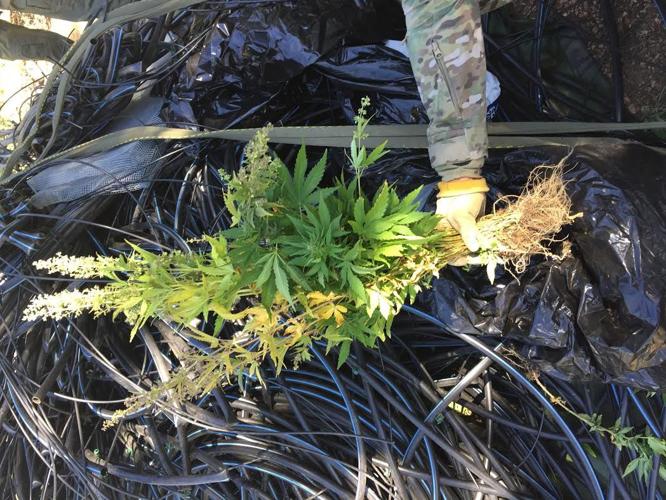
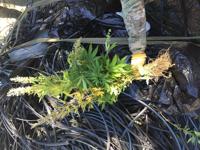



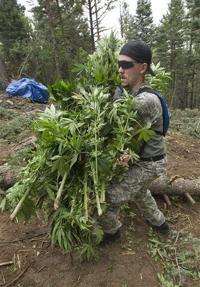



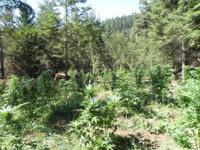





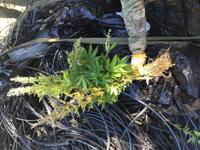



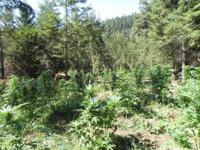
 Your Privacy Choices
Your Privacy Choices